WOC 167
Page 167
Writing Explanatory Essays
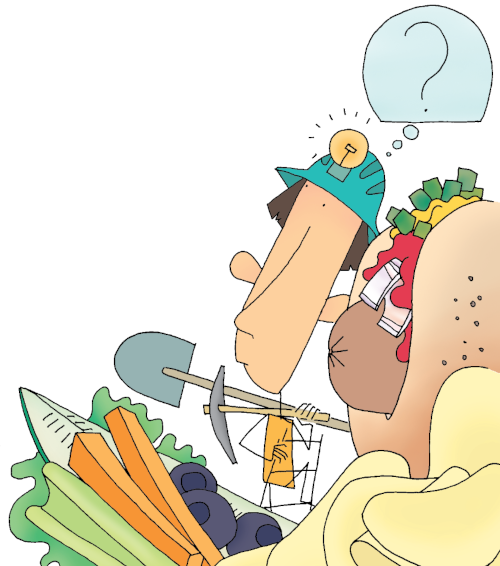
A Chicago-style hot dog has sport peppers, a dill pickle, tomato slices, and mustard. A New York-style hot dog includes sauerkraut, onion sauce, and mustard. A Michigan-style hot dog is covered in meat chili and cheese. . . .
You can build a hot dog however you want. The ingredients you choose will impact the flavor, aroma, color, and texture.
You can also build an explanatory essay however you want. You choose the topic and focus and load the essay with facts, statistics, examples, definitions, anecdotes, explanations, and so on. If you build your essay well, readers will gobble up your ideas and ask for more!
What’s Ahead
WOC 168
Page 168
Understanding Explanatory Writing
To explain a topic in writing, you need to understand it well. You also need to capture the reader’s attention and use the best form to explain your topic.
Consider the Writing Situation
To get started, think about the basic parts of the writing situation. Use the PAST strategy. (See page 6.)

Link to the Traits
Ideas ■
Select a topic that really interests you. Create a clear focus and support it with specific details.
Organization ■
Organize the details in the most informative way—time order, place order, order of importance, or logical order.
Voice ■
Use a voice that shows your knowledge of and interest in the topic and connects to your reader.
WOC 169
Page 169
Explanatory Writing Ideas
Explanatory writing is all about ideas. Once you identify a topic that really interests you, you’ll have fun learning about it and sharing what you know. You can find great topic ideas in the books you read, in your classroom, and out in the world. Here’s a list of other possible explanatory writing topics (see more):
All about . . .
aquifers, hot springs, glaciers, oil wells, salt mines, mud slides, forest fires, the Vietnam Veterans Memorial, Martin Luther King Jr., video games, dirt bikes, computer-generated animation, horses, cheerleading
Definition of . . .
a good time, a conservative, soul, a grandparent, loyalty, one type of music, advice, courage, hope, strength, fun, freedom, pride, arrogance, success
Kinds of . . .
weather, games, personalities, music, clothing, crowds, friends, commercials, dreams, neighbors, pains, joys, heroes, chores, homework, frustration, workouts, extreme sports, diets
How to . . .
skateboard, snowboard, surf, stand on your head, saddle a horse, show a dog, lift weights, recognize constellations, do origami, build a radio, make a favorite food, get from one place to another
Causes and effects of . . .
sunburn, acne, hiccups, tornadoes, dropouts, rust, computer viruses, arguments, droughts, climate change, war, recessions, booms, earthquakes, racism, sunspots
Comparing and contrasting . . .
soccer to football, rural life to city life, summer to fall, different types of heroes, new fashions to old, types of jobs, political parties, books, types of great apes, farming techniques, Aztecs to Egyptians
Helpful Hint
To write an essay based on any of the ideas in the first three categories, use the models and guidelines in this chapter. To write a how-to essay, a cause-effect essay, or a comparison-contrast essay, see the models and guidelines in the next chapter. For more help selecting a topic, see page 172.
WOC 170
Page 170
Explanatory Essay
Student writer Darrell Wade loves nature and science. He wrote the following explanatory essay to explore the science and wonder of a natural phenomenon.
Polar Light Shows
Beginning:
The beginning grabs the reader’s interest and leads to the thesis statement (underlined). The first record of the northern lights comes in a 30,000-year-old cave painting in France. From that time to this, people around the world have looked up in hopes of seeing one of these dramatic light shows. Curtains of red and green billow across the sky or whirl overhead. Auroras seem to cast a mystical spell on observers, but science can explain how they come to be.
Middle:
Each middle paragraph deals with a different part of the topic. Auroras start with the solar wind, a constant tide of charged particles thrown off by the sun. At high speeds, electrons crash into earth’s upper atmosphere and accelerate along its magnetic field lines toward the poles. The north and south poles of the earth are just like the north and south poles of a magnet. Electrons follow the field lines down toward the poles, where they energize gas atoms. As the atoms release their extra energy, they glow. Nitrogen glows red, and oxygen glows green—the most common colors in auroras. Neon lights glow from the same process.
Auroras can form at any time of day, but they are visible only in a dark sky. They tend to be best observed around midnight. Most auroras form in an oval around the polar region but then they can spread out, migrating away. Sometimes, auroras appear as far south as the lower 48 states. If the magnetic poles flip (as they have many times in the past), there will be a period when auroras will be visible everywhere.
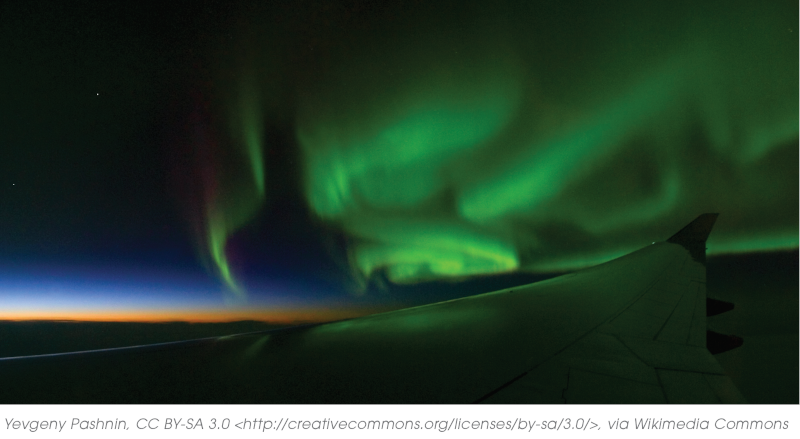
The writer elaborates with a variety of details. Auroras have mystified people throughout time. In 567 B.C.E., an astronomer of King Nebuchadnezzar II reported seeing the lights. For thousands of years, Viking legends held that auroras are reflections off the armor of the Valkyries, the goddesses who ride chariots through the skies to harvest the souls of warriors from battlefields. An Inuit legend says the lights are spirits playing ball with a walrus’s head. In 1619, Galileo first called these lights aurora after the Roman goddess of the dawn and borealis after the Greek god of the north wind. (Aurora australis means “dawn of the south”—the southern lights.)
A topic sentence begins each middle paragraph. Scientists are still discovering their mysteries. At the beginning of the 20th century, Kristian Birkeland first suggested that auroras come from the solar wind, but his theories were not accepted until the middle of the century. It took until 2021 for scientists to discover how the electrons surfed waves to reach their phenomenal speeds of 45 million miles per hour. The Parker Solar Probe was even sent to learn more about the solar wind by entering the sun’s corona!
Ending:
The ending leaves the reader with a powerful thought. Scientists and regular people may see auroras through different eyes, but all observers feel wonder. The dazzling curtains of light billowing from horizon to horizon should be reason enough. However, auroras are even more wonderful as reminders that our atmosphere is protecting us from the ravages of the solar wind.
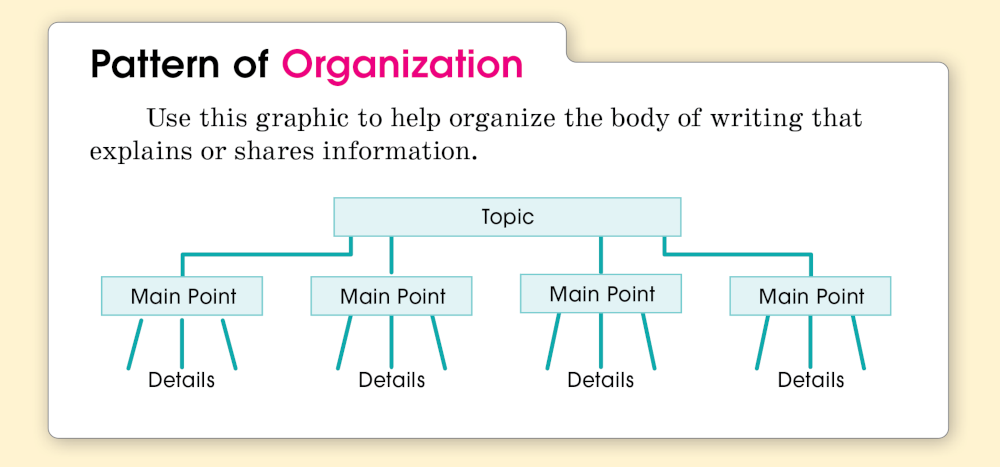
WOC 172
Page 172
Writing Guidelines
Prewriting ■ Selecting a Topic
Use the Essentials of Life Checklist to choose a topic. Darrell reviewed this checklist and chose the category “science” to start his topic search. (See below.) Or review the ideas on page 169 for possible topics.
Essentials of Life Checklist
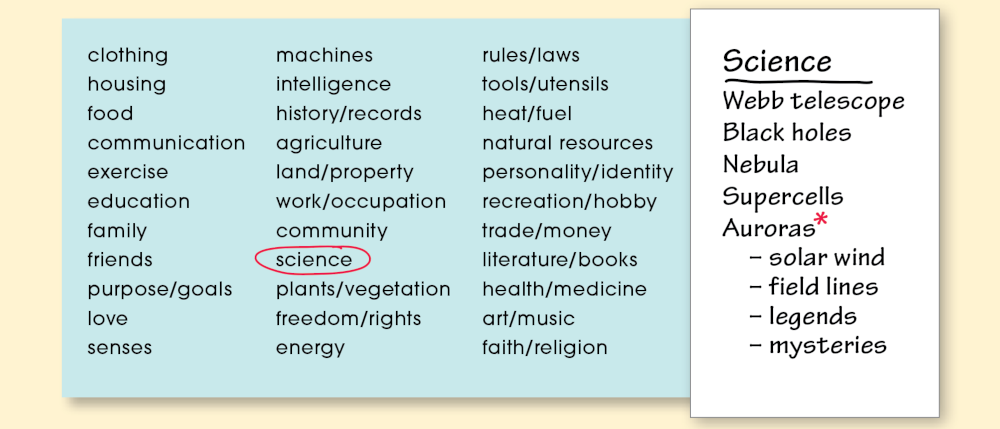
Gathering Details
Once you’ve chosen a topic that interests you, find out as much as you can about it. Darrell created a KWL chart listing what he knew, wondered about, and learned through research.
KWL Chart
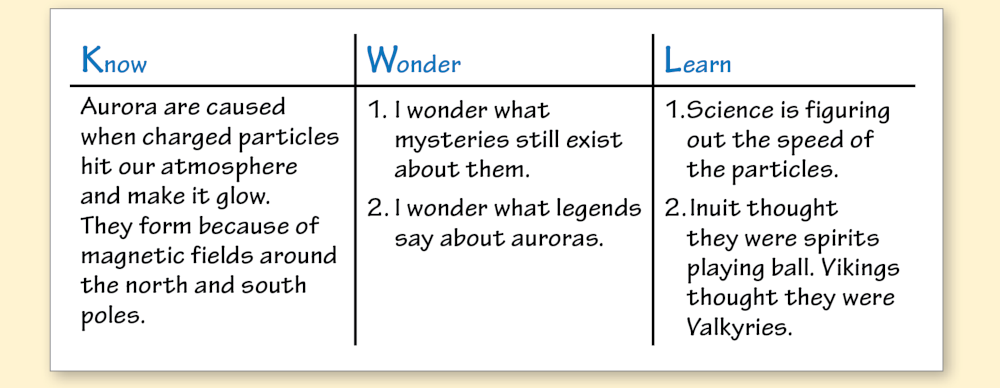
WOC 173
Page 173
Using Different Types of Details
The most effective explanatory writing overflows with wonderful details. As you gather details for your essay, remember that different types of details have different effects on the reader.
Types of Details Chart
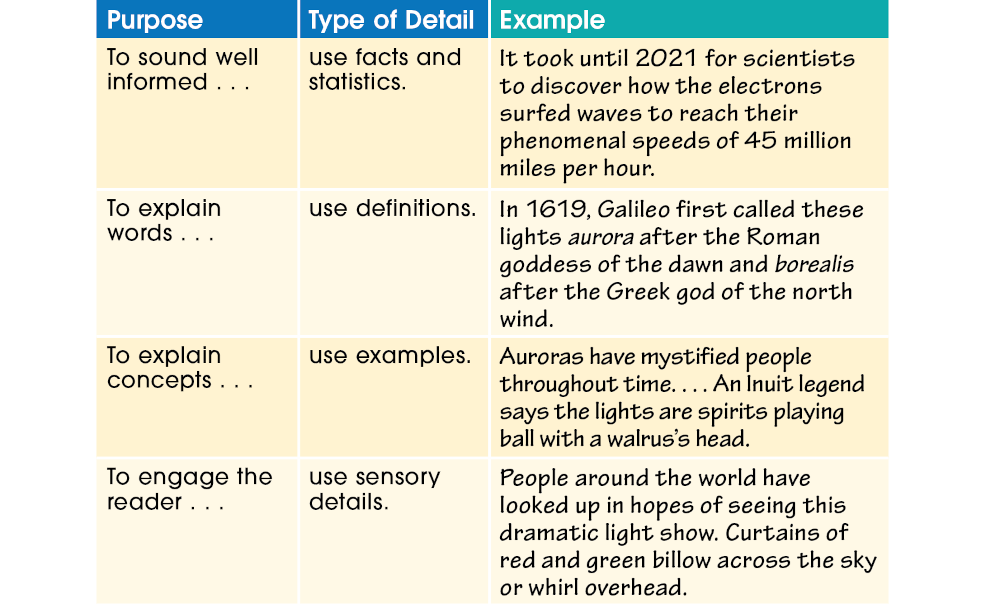

WOC 174
Page 174
Writing ■ Developing the First Draft
Carefully develop each part of your essay, following these guidelines.
Beginning ■ The beginning should grab your reader’s attention and state your thesis. Begin your essay with one of the attention-getting ideas that follow. Then write your thesis statement using the formula below as a guide.
- Start with an amazing fact:
The first record of the northern lights comes in a 30,000-year-old cave painting in France.
- Start with a powerful anecdote:
Imagine being a Viking warrior after battle and seeing the Valkyries sweep down to carry your fallen friends away. . . .
- Start with an intriguing question:
Have you ever seen the glowing curtain of our planetary defense?
Thesis Statement Formula

Middle ■ The middle should include main points that support your thesis. Each paragraph should develop a separate main point. Use different types of details to elaborate each main point. (See page 173.)
Ending ■ The ending paragraph should wrap up your essay in a thoughtful way. Try one of the following strategies:
- Restate your thesis:
Scientists and regular people may see auroras through different eyes, but all observers feel wonder.
- Fire the reader’s imagination:
The dazzling curtains of light billowing from horizon to horizon should be reason enough.
- Leave the reader with a thought-provoking idea:
However, auroras are even more wonderful as reminders that our atmosphere is protecting us from the ravages of the solar wind.
Scientists and regular people may see auroras through different eyes, but all observers feel wonder.
The dazzling curtains of light billowing from horizon to horizon should be reason enough.
However, auroras are even more wonderful as reminders that our atmosphere is protecting us from the ravages of the solar wind.
WOC 175
Page 175
Revising ■ Improving Your Writing
When you revise your explanatory essay, you add, cut, move, and rework ideas to make your writing stronger. Here’s a quick checklist to guide your revising:
Revising Checklist
_____ Ideas Is my thesis statement clear and supported by a variety of details?
_____ Organization Do my beginning, middle, and ending work well?
_____ Voice Do I sound knowledgeable and interested?
_____ Word Choice Do I define any special terms? (See below.)
_____ Sentences Do my sentences read smoothly?
A Closer Look at Revising ■ Word Choice
If your essay contains special terms that may be unfamiliar to readers, you should provide definitions. Here are three ways:
- Provide an actual definition:
Auroras are dramatic light shows of red and green curtains rippling around the poles of our planet.
- Rename the word with an appositive:
Auroras start with the solar wind, a constant tide of charged particles thrown off by the sun.
(The appositive is the part of the sentence that follows the comma, and it renames solar wind.) - Provide word clues:
The north and south poles of the earth are just like the north and south poles of a magnet. Electrons follow the field lines down toward the poles . . .
(Here, words like poles and magnet help the reader know what field lines refers to.)
Editing ■ Checking for Conventions
When you edit your explanatory essay, you polish its punctuation, capitalization, spelling, and grammar. Here is a quick checklist to guide your editing.
Editing Checklist
Conventions
_____ Do I use end punctuation and commas correctly?
_____ Do I correctly capitalize first words and proper nouns?
_____ Do I avoid spelling errors?
_____ Do I correctly use easily confused words (there, they’re, their)?
